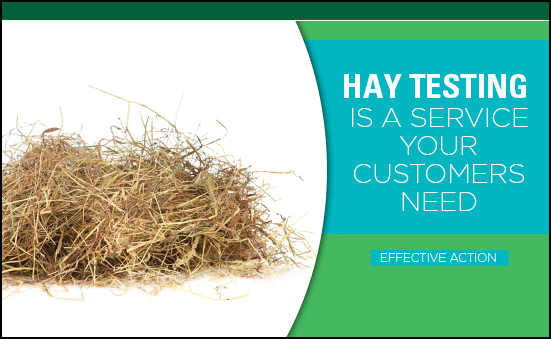The adage “you can’t judge a book by its cover” is also true for the nutrient quality of hay. Just because a particular cutting of hay looks superior to another doesn’t mean it has the nutrients that a cow herd needs to thrive. That’s why it’s important to BioZyme ® Inc. to provide forage testing to its customers – to make sure proper nutrients are getting to the cattle when they are most needed.
“Forage testing is an extremely important service we offer as part of the BioZyme services so we can align nutritional programs to our customers’ specific needs,” said Jack Oattes, BioZyme’s Regional Business Manager in Canada, on a recent Facebook Dealer Training.
Forage testing is a management practice that helps you plan ahead to make the best nutritional decisions for your herd. Testing in the early fall will help your customers know which forages to feed during which stages of production and the proper amounts of protein and energy they need to supplement.
Before collecting forage samples, be sure each lot of hay is identified by field and cutting number so the producer will know which sample came from which lot. For example, nutrient needs peak at lactation as the cow is trying to maintain her own condition, raise a calf and prepare for breed-back, so producers will want to make sure their highest quality hay is kept from that lot for that period of the production cycle.
Once you collect the samples, work with your Area Sales Manager to get them sent in and analyzed. The results are typically generated within a week, indicating any deficiencies in energy or protein. In addition to knowing the nutrient content of your forages, it is also important to know the amount of each lot of hay the customer has and the number of cows to feed when working with the BioZyme Nutrition Team to plan the next steps.
“If we don’t know the analysis, it’s hard to know what to do,” said Dan Shike, Associate Professor of Animal Science, University of Illinois, during the dealer training.
In addition to forages, Shike said producers might consider other feed alternatives like crop residues, bakery or grocery store wastes. Regardless of the feedstuffs, the nutritional value needs to be known so proper supplementation can take place. Shike also reminds that feeding must consider the cost per unit of energy or cost per unit of protein, and those calculations need to factor in more than just the feed and supplements.
“Not one size fits all. We need to think about equipment and labor,” he said.
After the tests are analyzed and interpreted and the protein and energy needs are determined, there are five ways to supplement proteins using the Amaferm ® advantage.
Feed mineral with Amaferm. Get the most out of what your cows are consuming by increasing intake and digestibility. This is the least expensive option as the added cost of Amaferm is less than 5 cents per cow, per day.
Feed VitaFerm® Concept•Aid® Protein Meal. This is a granular, free-choice mineral. In addition to the mineral, supplemental protein is provided. Feed VitaFerm Concept•Aid Protein Tub. The tub provides the same nutrition as the protein meal but adds the convenience of the tub form.
Feed VitaFerm 30-13% Protein Tub. This VitaFerm product offers the highest level of protein, but vitamin and mineral levels for maintenance during times of year when nutrient requirements are not as high.
Feed VitaFerm Conserve® Protein Tub. This economical vitamin and mineral supplement for beef cattle that supports the health and condition of the whole herd with 20% protein.
